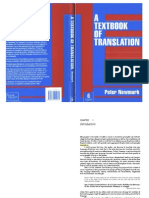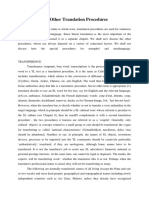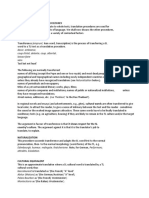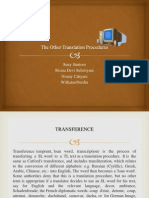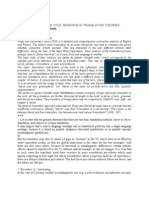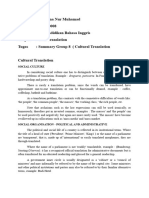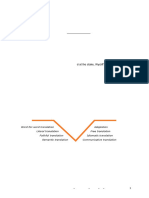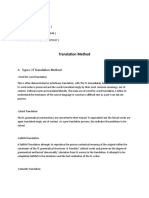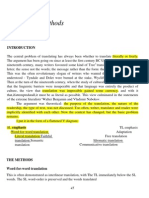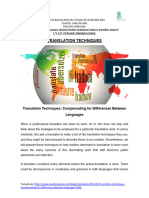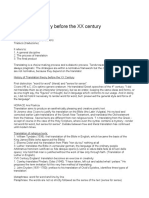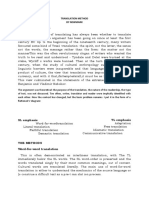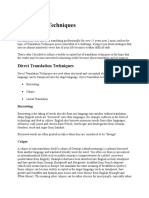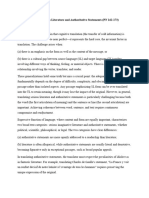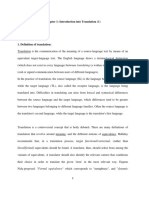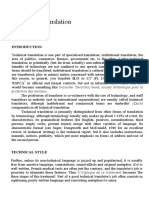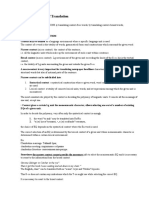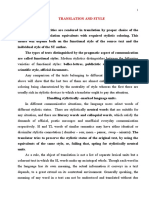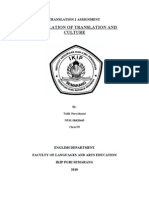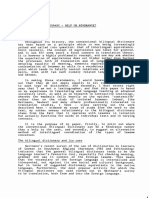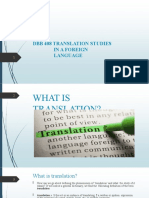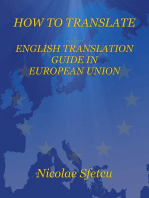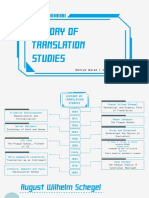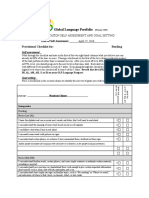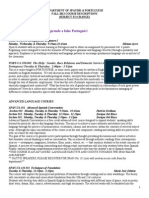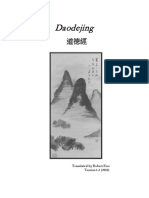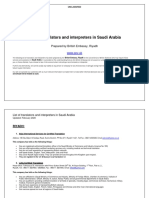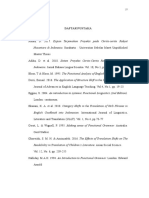Newmark Chapter Procedures
Newmark Chapter Procedures
Uploaded by
Giang VuCopyright:
Available Formats
Newmark Chapter Procedures
Newmark Chapter Procedures
Uploaded by
Giang VuOriginal Description:
Original Title
Copyright
Available Formats
Share this document
Did you find this document useful?
Is this content inappropriate?
Copyright:
Available Formats
Newmark Chapter Procedures
Newmark Chapter Procedures
Uploaded by
Giang VuCopyright:
Available Formats
CHAPTER
The Other Translation Procedures
While translation methods relate to whole texts, translation procedures are used for sentences and the smaller units of language. Since literal translation is the most important of the procedures, we have discussed it in a separate chapter (Chapter 7). We shall now discuss the other procedures, whose use always depends on a variety of contextual factors. We shall not discuss here the special procedures for metaphor and metalanguage.
TRANSFERENCE Transference (emprunt, loan word, transcription) is the process of transferring a SL word to a TL text as a translation procedure. It is the same as Catford's transference, and includes transliteration, which relates to the conversion of different alphabets: e.g. Russian (Cyrillic), Greek, Arabic, Chinese, etc- into English, The word then becomes a 'loan word'. Some authorities deny that this is a translation procedure, but no other term is appropriate if a translator decides to use an SL word for his text, say for English and the relevant language, decor, ambiance, Schadenfreude; the French diplomatic words: coup d'etat, detente, coup, attentat, demarche; dachshund, samovar, dacha, or for German Image, Job, *last but not least*. However, when the translator has to decide whether or not to transfer a word unfamiliar in the target language, which in principle should be a SL cultural word whose referent is peculiar to the SL culture (see Chapter 9), then he usually complements it with a second translation procedure - the two procedures in harness are referred to as a 'couplet1. Generally, only cultural'objects1 or concepts related to a small group or cult should be transferred; the vogue for transferring so called "national characteristics' {Gemiittichkeit, machismo, dotce vita) should be abandoned. Needless to say, in principle, the names of SL objects, inventions, devices, processes to be imported into the TL community should be creatively, preferably 'authoritatively', translated, if they are neologisms, although brand names have to be transferred. It is nor the translator's job to assist any SL advertiser's financial, national or personal prestige interests. At the same time, one cannot be rigid or dogmatic. The media, the experts, will be transferring words 81
82
PRINCIPLES
whether the translators like it or not. Perhaps when the translator's professional status is raised, they will not be transferring so many. The following are normally transferred: names of all living (except the Pope and one or two royals) and most dead people; geographical and topographical names including newly independent countries such as (le) Zaire, Malawi, unless they already have recognised translations (see Naturalisation below); names of periodicals and newspapers; titles of as yet untranslated literary works, plays, films; names of private companies and institutions; names of public or nationalised institutions, unless they have recognised translations; street names, addresses, etc. (rue Thaibaut\ lin the Rue Thaibaut'). In all the above cases, a similar type of readership is assumed andt where appropriate, a culturally-neutral TL third term, i.e. a functional equivalent, should be added, In regional novels and essays (and advertisements, e.g., gites), cultural words are often transferred to give local colour, to attract the reader, to give a sense of intimacy between the text and the reader - sometimes the sound or the evoked image appears attractive. These same words have to be finally translated in non-literary texts (e.g. on agriculture, housing) if they are likely to remain in the TL culture and/or the target language. There are often problems with the translation of "semi-cultural1 words, that is abstract mental words which are associated with a particular period, country or individual e.g., lmaximalism\ 'Enlightenment', Sartre's 'nothing-ness1 (neam) or Heidegger's Dasein. In principle, such words should first be translated, with, if necessary, the transferred word and the functional equivalent added in brackets, until you are confident that your readership recognises and understands the word-Unfortunately such terms are often transferred for snob reasons; 'foreign' is posh, the word is untranslatable. But the translator's role is to make people understand ideas (objects are not so important), not to mystify by using vogue-words. Freud's formidable key-terms may have been mistranslated, but at least they were translated. The argument in favour of transference is that it shows respect for the SL country's culture- The argument against it is that it is the translator's job to translate, to explain.
NATURALISATION This procedure succeeds transference and adapts the SL word first to the normal pronunciation, then to the normal morphology (word-forms) of the TL, e.g. Edimbourgh, humeur, redingote, thatcherisme. Note, for German, Performanz, aitrakiiv, Exhalation.
CULTURAL EQUIVALENT This is an approximate translation where a SL cultural word is translated by a TL
THE OTHER TRANSLATION PROCEDURES
83
cultural word; thus baccalauriai is translated as '(the French) "A" level', or Abitur (MatUTa) as '(the German/Austrian) "A'1 level1; Palais Bourbon as '(the French) Westminster1; Montecitorio as '(the Italian) Westminster'; charcuterie - 'delicatessen' (now English 'deli1); notaire - Solicitor'. The above are approximate cultural equivalents- Their translation uses are limited, since they are not accurate, but they can be used in general texts, publicity and propaganda, as well as for brief explanation to readers who are ignorant of the relevant SL culture. They have a greater pragmatic impact than culturally neutral terms. Occasionally, they may be purely functionally, hardly descriptively, equivalents, e,g., le cyclisme, 'cricket1, 'baseball'; 'tea break1, cafe-pause; carte a"'identity, 'car licence'. Functional cultural equivalents are even more restricted in translation, but they may occasionally be usedif the term is of little importance in a popular article or popular fiction. They are important in drama, as they can create an immediate effect. 'He met her in the pub * -III' a retrouvee dans le cafe. Or again, vingt mitres derriire lui - 'twenty yards behind him*. However, the main purpose of the procedure is to support or supplement another translation procedure in a couplet,
FUNCTIONAL EQUIVALENT This common procedure, applied to cultural words, requires the use of a culture-free word, sometimes with a new specific term; it therefore neutralises or generalises the SL word; and sometimes adds a particular thus: baccalauriat - Trench secondary school leaving exam'; Sejm - 'Polish parliament1; 'Roget' - dictionnaire ideologique anglais. This procedure, which is a cultural componential analysis, is the most accurate way of translating i.e. deculturalising a cultural word. A similar procedure is used when a SL technical word has no TL equivalent, Thus the English term 'cot death' translates as mart subite d'un nourrissoni although the components 'unexpected* and 'without known reason1 are here omitted from the French. This procedure occupies the middle, sometimes the universal, area between the SL language or culture and the TL language or culture. If practised one to one, it is an under-translation (e.g. d^gringoler as 'tumble'). If practised one to two, it may be an over-translation. For cultural terms, it is often combined with transference: tattle> as 'a tax on the common people before the Ftench Revolution, or taille\ I refer to the combination of two translation procedures for one unit as a 'couplet'.
DESCRIPTIVE EQUIVALENT In translation, description sometimes has to be weighed against function. Thus for machete, the description is a 'Latin American broad, heavy instrument 1, the function is 'cutting or aggression1; description and iunction are combined in
84
PRINCIPLES
'knife1. Samurai is described as 'the Japanese aristocracy from the eleventh to the nineteenth century*; its function was *to provide officers and administrators', Description and function arc essential elements in explanation and therefore in translation. In translation discussion, function used to be neglected; now it tends to be overplayed.
SYNONYMY I use the word 'synonym1 in the sense of a near TL equivalent to an SL word in a context, where a precise equivalent may or may not exist. This procedure is used for a SL word where there is no clear one-to-one equivalent, and the word is not important in the text, in particular for adjectives or adverbs of quality (which in principle are 'outside' the grammar and less important than other components of a sentence): thus personne gentille, 'kind' person; conte piquant, 'racy story'; 'awkward' or 'fussy', difficile; 'puny effort1, effort faible. A synonym is only appropriate where literal translation is not possible and because the word is not important enough for componential analysis. Here economy precedes accuracy. A translator cannot do without synonymy; he has to make do with it as a compromise, in order to translate more important segments of the text, segments of the meaning, more accurately. But unnecessary use of synonyms is a mark of many poor translations.
THROUGH-TRANSLATION The literal translation of common collocations, names of organisations, the components of compounds (e.g. 'superman1, Ubermmsch) and perhaps phrases (compliments de fa saison^ 'compliments of the season'), is known as caique or loan translation. I prefer the more transparent term 'through-translation'. In theory, a translator should not 'initiate' a through-translation. In fact, through-translations in contiguous cultures sometimes fill in useful gaps, and perhaps it is time that 'Good appetite7, 'through-compose1, 'leading motive3, 'relaxation1 (for detente), 'no longer the youngest', 'birthday child*, should finally enter familiar English, The most obvious examples of through-translations are the names of international organisations which often consist of 'universal* words which may be transparent for English and Romance languages, and semantkally motivated for Germanic and Slavonic: e.g., EEC, Communaute'Economique Europeenne, Europdische Wirtschaftsgemeirtschaft (EWG, now EG)\ European Cultural Convention, Convention culturelle europeenne; groupe d'gtudes, 'study group' but Arbeitsgruppe; 'working party', commission d'enquexe, Arbeitsausschuss. International organisations are often known by their acronyms, which may remain English and internationalisms (UNESCO, UNRRA, FAO) or French FIT (International Federation of Translators), but more often switch in various Ian-
THE OTHER TRANSLATION PROCEDURES
55
gii^gesaLO^BITi^JAOiGy^UO.OMSiF^WGOiG^NATO.OTANiF), NATO(G)). Translated brochures, guide-books and tourist material are apt to pullulate with incorrect through-translations: 'highest flourishing', 'programme building', etc., which are evidence of translationese. Normally, through-translations should be used only when they are already recognised terms, SHIFTS OR TRANSPOSITIONS A 'shift* (Catford's term) or 'transposition1 (Vinay and Darbelnet) is a translation procedure involving a change in the grammar from SL to TL. One type, the change from singular to plural, e.g. 'furniture'; des meublest 'applause', des applaudis-sements; 'advice', des consetis; or in the position of the adjective: la maison blanche, 'the white house' is automatic and offers the translator no choice. A second type of shift is required when an SL grammatical structure does not exist in the TL. Here there are always options. Thus for the neutral adjective as subject, I'interessant, e'estque; das Inieressanteist, dafi, V inieressanteeche . , ., there is a choice of at least: 'What is interesting is that. . .', 'The interesting thing is that . . .', 'It's interesting that . . ,', The interest of the matter is that. . ,\ (But for French and Italian, it may be 'valuable' or 'useful' depending on the various contextual factors.) Again the English gerund ('Working with you is a pleasure*) offers many choices. The gerund can be translated by verb-noun (le travail, die i4rfceir),orasubordinateclause('when,if,etc. I work with you'), with a recast main clause, or, in some languages, a noun-infinitive (e.g. das Arbeiten, which is formal style), or an infinitive. I think the gerund is the most neglected of all translator's transpositions, e.g., Wenn Humboldt den Auftrag . , . erhielt, so warm das mehreren Faktoren zu danken 'Several factors were responsible for Humboldt's receiving the commission'. Note also the English 'do' auxiliary, 'do come*: komm dock (or mal)\ viens done. French has 'venirde* plus the infinitive: il vient de le faire is usually translated by 'recently' or 'just'. Again, Italian's reflexive infinitives (per il precisarsi degli effetti negaiivi, 'by stating the negative effects', 'when the negative effects are stated'; il suo espandersi, 'its expansion1, 'the process of its expansion'; I'esserci imbattuta in un caso, 'since we have come upon a case', 'the fact that we have come upon a case') offer several choices. German has active or passive participial constructions which are normally translated by adjectival clause or non-finite participial clauses. Thus Beijeder sick bietenden Gelegenheit may be: 'At every opportunity that occurs' or 'At every available opportunity' or 'Whenever the opportunity occurs1 or 'At every opportunity' (taking sick bieten as an empty verb). Again, Im Sinn dervon der Regierung verfolgien Ziele (Wilss, 1982) may be 'In accordance with the aims pursued by the government', 'In accordance with the aims which che government are pursuing' or 'in accordance with the government's aims' - ihe three translations indicate a different degree of emphasis.
86
PRINCIPLES
The third type of shift is the one where literal translation is grammatically possible but may not accord with natural usage in the TL. Here Vinay and Darbelnet's pioneering book and a host of successors give their preferred translations, but often fail to list alternatives, which may be more suitable in other contexts or may merely be a matter of taste. (Grammar, being more flexible and general than lexis, can normally be more freely handled.) Thus, for SL verb, TL adverb: Notre commerce avec Vetranger n'a cesse de s'ameliorer, lOur foreign trade has improved steadily (continuously)', 'Our foreign trade has shown continuous improvement1; II ne tardera pas a rentrer, *He will come back soon', 'He'll be back (return) in a moment (shortly)'; La situation reste critique, 'The situation is still critical', lThe situation remains critical'. In other cases Vinay and Darbelnet, sometimes rather arbitrarily, offer one out of many possible translations; there is nothing wrong with this, but they should have stated the fact. The translator is always concerned with questions of currency and probability, and mere is a great difference between Des son lever, Las soon as he gets up', where lever shows up an English lexical gap and therefore the translation has a high degree of probability, and Des qu'on essaie d'etre arbitraire, on est tout de suite aux prises avec des contradictions, 'Any attempt to be arbitrary at once involves one in inconsistencies', where ten translators might produce ten different versions, and the semi-literal translation: 4As soon as one tries to be arbitrary, one is immediately faced with contradictions1 ought, at first sight, to be the most probable. But Vinay and Darbelnet's prejudice against literal translation (admirably discussed in Wilss, 1982) has become notorious and has had a baneful influence on translation teaching if not translation. Incidentally, the last example contains several transpositions in Vinay and Darbelnet's version: (1) (2) (3) (4) (5) (6) SL verb, TL noun (essaie, 'attempt') SL conjunction, TL indefinite adjective (des que, uany') SL clause, TL noun group (dis qu'on essaie, 'any attempt') SL verb group, TL verb {est aux prises, 'involves') SL noun group, TL noun (des contradictions, 'inconsistencies') SL complex sentence, TL simple sentence (etc!)
However, the fact that it is not possible to strictly standardise transpositions in the way that Vinay and Darbelnet do- since so many overlap and convert to lexis (what Catford calls "Level-shifts' e.g., apressamorr, 'after she had died'), in noway detracts from their usefulness, and you should become sensitised to their possibilities. Further, there are a number of standard transpositions from Romance languages to English which are worth noting even though they all have alternative translations: (1) SL adjective plus adjectival noun. TI. adverb plus adjective; d'une importance exceptionnelle, * exceptionally large1 (2) SL prepositional phrase, TL preposition: au lerme det 'after' (cf. dans le cadre de, au niveau dey a ['exception de, au depart de)
THE OTHER TRANSLATION PROCEDURES
87
(3) SL adverbial phrase, TL adverb: d'une maniere bourrue, 'gruffly1 (4) SL noun plus adjective of substance, TL noun plus noun: la cellule nerveuse, I nerve cell' (5) SL verb of motion, with en and present participle of description, TL verb of description plus preposition (Vinay and Darbelnet's 'criss-cross' transposition): II gagna la/entire en rampant^He crawled to the window* (6) SL verb, TL empty verb plus verb-noun: Jtrit, lhe gave a laugh' (7) SL noun plus (empty) past participle or adjectival clause (etc.) plus noun, TL noun plus preposition plus noun (the 'house on the hill' construction): Le ctfrnp/of^mrdiconrrejui,'the plot against him1; to ^ 'the tower on the hill' (8) SL participial clause (active and passive), TL adverbial clause or (occasionally) group, as in the following scheme: SL participial clause (active) * TL adverbial clause (group) L'unite francaise renaissante, ('opinion pHera 'As French unity is reviving (with the de nouveau rebirth of French unity) public opinion will carry weight again* SL participial clause (active) Le moment arrvt^je serai pret -* TL adverbial clause (or group) 'When the time comes (at the right time) Til be ready1
The fourth type of transposition is the replacement of a virtual lexical gap by a grammatical structure, e.g, aprissa sortie^ 'after he'd gone out'; il le cloua au piloriy 'he pilloried him'; ilatteint le total, 'it totals'; 'he pioneered this drug*, il a iU Vun des pionniers de ce medicament. Certain transpositions appear to go beyond linguistic differences and can be regarded as general options available for stylistic consideration. Thus a complex sentence can normally be converted to a co-ordinate sentence, or to two simple sentences: Si lui est aimable, safemme est arrogante - 'He is (may be) very pleasant, but his wife is arrogant1 - 'He is pleasant; his wife, however, is arrogant'. This also works the other way round, although some would say that English, influenced by the King James Bible (Hebrew), prefers simple or co-ordinate to complex sentences. Again many languages appear to be capricious in converting active verbs to animate nouns, thus: 'He is a heavy drinker1 - // boit sec\ La tdche d'un exdeuteur fidele a"instructions recues - 'The task of someone (one) who faithfully carries out the instructions they (he) have (has) received1 (note the attempt to de-sex language); Une equipedepreleveurs-*A staff icam to take (blood) samples1. A group of typical transpositions centre on a Romance-language subject: (1) M. Tesniere, grammarien, m'a aide 'M, Tesniere (who was) a grammarian, helped me* (2) Une fois parti, M* Tesniere . . . 'once (when) he had left, M. Tesniere . . /
88 {3} Ce livre, intiressant, m'esi venu a t'esprit - 'The hook, which was (as it was, though it was) interesting, came to my mind' (4) L'homme,quifaisait. . . - The man doing . . .
PRINCIPLES
The last point I want to mention ahout transpositions is that they illustrate a frequent tension between grammar and stress. To take an example, should you translate Seine Aussage ist schtechthin unzutreffend by 'His statement is (a) completely false (one)' or There is absolutely no truth in his statement1? My only comment is that too often the word order is changed unnecessarily, and it is sometimes more appropriate to translate with a lexical synonym, retain the word order and forgo the transposition in order to preserve the stress. Transposition is the only translation procedure concerned with grammar, and most translators make transpositions intuitively. However, it is likely that comparative linguistics research, and analysis of text corpuses and their trans-lations, will uncover a further number of serviceable transpositions for us.
MODULATION Vinay and Darbelnet coined the term 'modulation' to define la variation through a change of viewpoint, of perspective {eclairage) and very often of category of thought'. Standard modulations such as chateau d'vau? 'water-tower', are recorded in bilingual dictionaries. Free modulations are-used by translators 'when the TL rejects literal translation', which, by Vinay and Darbemet's criteria, means virtually always. Further, modulations are divided into eleven rather random categories, whilst the - in my opinion - only important one, the 'negated contrary' (sic), is not discussed. As I see it, the general concept, since it is a super-ordinate term covering almost everything beyond literal translation, is not useful as it stands. However, the 'negated contrary', which I prefer to call ^positive for double negative' (or ^double negative for positive') is a concrete translation procedure which can be applied in principle to any action (verb) or quality (adjective or adverb): 11 n'a pas hesite - lHe acted at once' // n'est pas lache - LHe is extremely brave' You will note that the translations are free, and in theory the double negative is not as forceful as the positive; in fact the force of the double negative depends on the tone of voice, and therefore the appropriateness of this modulation must depend on its formulation and the context. In the few cases where there is a lexical gap in an opposition (e.g. 'shallow'; peu profond), this modulation is virtually mandatory. In all other sentences the procedure is potentially available, but you should only use it when the translation is not natural unless you do so. Thus 'minor' collocated with, say, 'detail' seems to
THE OTHER TRANSLATION PROCEDURES
89
call for a translation such as sans importance? unbedeutend, although petit* klein, etc., remain as alternatives. Again, Lit will not seem unlikely that1 is perhaps best translated as il est fori probable que . . . In other cases, the procedure is merely a 'candidate* for use, e,g. 'He made it plain to him' - it ne te tui cacha pas., it le luifit comprendre; 'Men will not always die quietly' (J. M. Keynes) - Les kommes ne mourront pas toujours sans se piaindre; "no mean city1 - cite qui n'est pas sans importance; Lno mean performer on the violin' - iljoue superieurement du vioion. Vinay and Darbelnet's second modulation procedure, 'part for the whole', is rather misleadingly described; it consists of what I can familiar alternatives, viz, te 14 juillet (fete nationale); Vkomme du 18 juin (De Gaulle); iafille atn4e de i'Eglise (France); 'Athens of the North' (Edinburgh), The other modulation procedures are: (a) abstract for concrete ('sleep in the open', dormir a la belle etotle); (b) cause for effect ('You're quite a stranger', On ne vous voit plus); (c) one part for another ('from cover to cover', de ia premiere a la derniere page)\ (d) reversal of terms (lebensgefahrlick> danger demort\ n'appelezpasdu has de rescalier, 'don't call up the stairs'; assurance-maladie, 'health insurance*); (e) active for passive; (0 space for time ('as this in itself (space) presented a difficulty', lcela presemant deja (time) une difficulte)\ (g) intervals and limits; (h) change of symbols. Of these procedures, 'active for passive' (and vice versa) is a common transposition, mandatory when no passive exists, advisable where, say, a reflexive is normally preferred to a passive, as in the Romance languages. Reversal of terms (Nida's 'conversive' terms) is also a distinct procedure, usually optional for making language sound natural; *buy/selF, 'lend/borrow', hauteur d'eauj1 depth of water'; for English 'loan' there are alternatives in other languages and cHance translates 'claim* as 'credit* or 'debt' depending on the point of view. You will note that though I think Vinay's and Darbelnet's categorisation of modulation unconvincing, their abundant translation examples are always stimulating.
RECOGNISED TRANSLATION You should normally use the official or the generally accepted translation of any institutional term. If appropriate, you can gloss it and, in doing so, indirectly show your disagreement with this official version. Thus Mitbestimmung (in management) has to be translated first as 'co-determination'; Rechtsstaat as 'constitutional state'. Personally I think 'co-determination' is a poor translation of Mitbestimmung though it has the virtue of distinctiveness and brevity. (Compare the plainer but clumsier 'employers' and workers' joint management 1.) But it is now too late to change the term to 'workers' participation', and if you did so in any official or serious informative text, you would cause confusion. Similarly, when translating Gay-Lussac's Volumengesetz der Case it is no good giving it your own title or even a brief explanation; nothing but the accepted term ('law of combining volumes 1) will do.
90 TRANSLATION LABEL
PRINCIPLES
This is a provisional translation, usually of a new institunonal term, which should be made in inverted commas, which can later be discreetly withdrawn. It could be done through literal translation, thus: 'heritage language', Erbschafisspracke, tangue dy heritage. COMPENSATION This is said to occur when loss of meaning, sound-effect, metaphor or pragmatic effect in one part of a sentence is compensated in another part, or in a contiguous sentence. COMPONENTIAL ANALYSIS (see Chapter 11) This is the splitting up of a lexical unit into its sense components, often one-to-two, -three or -four translations. REDUCTION AND EXPANSION These are rather imprecise translation procedures, which you practise intuitively in some cases, ad Aoc in others. However, for each there is at least one shift which you may' like to bear in mind, particularly in poorly written texts: (1) SL adjective of substance plus general noun, TL noun: atleimes infiammatoires et infectieuses, * inflammations and infections1; science linguistique (etc.), 'linguistics'. (2) For expansion, a not uncommon shift, often neglected, is SL adjective, English T L adverb plus past participle, or present participle plus object: cheveux igaux^ 'evenly cut hair1; belebend, life-giving', PARAPHRASE This is an amplification or explanation of the meaning of a segment of the text. It is used in an 'anonymous' text when it is poorly written, or has important implications and omissions. OTHER PROCEDURES Vinay and Darbelnet also give: (1) Equivalence, an unfortunately named term implying approximate equivalence, accounting for the same situation in different terms. Judging from Vinay and
THE OTHER TRANSLATION PROCEDURES
91
Darbelnet's examples, they are simply referring to notices, familiar alternatives, phrases and idioms - in other words, different ways of rendering the cliches and standard aspects of language, e.g. The story so far\ Resume des chapitres precedents. (2) Adaptation: use of a recognised equivalent between two situations. This is a matter of cultural equivalence, such as 'Dear Sir1 translated as Monsieur; 'Yours ever* as Amities. Both the above illuminate what sometimes happens in the process of translating, but they are not usable procedures. As I see it, there are about fourteen procedures within a certain range of probability which are useful to the translator.
COUPLETS Couplets, triplets, quadruplets combine two, three or four of the above-mentioned procedures respectively for dealing with a single problem. They are particularly common for cultural words, if transference is combined with a functional or a cultural equivalent. You can describe them as two or more bites at one cherry. Quadruplets are only used for metalingual words: thus, if you translate the sentence: 'The nominal-tn^ clause, a participial clause, occurs in the subject position', apart from a more or less literal translation of 'nominal-mg clause', you might also: (a) transfer it; (b) explain, in an adjectival clause, that the present participle is used as a kind of gerund in English; (c) produce a translation label; (d) give an example, with TL literal and functional translations! You will note my reluctance to list 'paraphrase' as a translation procedure, since the word is often used to describe free translation. If it is used in the sense of * the minimal recasting of an ambiguous or obscure sentence, in order to clarify it', I accept it.
NOTES, ADDITIONS, GLOSSES Lastly, here are some suggestions about 'Notes' (when and when not to use them) or supplying additional information in a translation. The additional information a translator may have to add to his version is normally cultural (accounting for difference between SL and TL culture), technical (relating to the topic) or linguistic (explaining wayward use of words), and is dependent on the requirement of his, as opposed to the original, readership. In expressive texts* such information can normally only be given outside the version, although brief 'concessions* for minor cultural details can be made to the reader, e.g. perhaps by translating Hemingway's 'at HandleyV by dans le bar Handley, in der Handley Bar^ etc. In vocative texts, TL information tends to replace rather than supplement SL information. Thus if you translate 'you can pay for ceramic tiles
92
PR1NUPLLS
under a convenient credit purchase scheme* the latter term may be 'translated 1 by the more precise Mong-term payment facility'. Additional information in the translation may take various forms: (1) Within the text (a) As an alternative to the translated word: e.g., la gabelle becomes 'the gabelle, or salt-tax*. (b) As an adjectival clause: e.g., la taille becomes 'la taille, which was the old levy raised in feudal times from the civilian population*. (c) As a noun in apposition: e.g., les traiies becomes 'the traites, customs dues (d) As a participial group: e.g. , Voctroi becomes "Voctroi^ taxes imposed on food stuffs and wine entering the town1. (e) In brackets, often for a literal translation of a transferred word: e.g. das Kombinat becomes 'the kombinat (a "combine" or "trust")'. (f) In parentheses, the longest form of addition: e.g., aides becomes 'aides -these are excise dues on such things as drinks, tobacco, iron, precious metaJs and leather-were imposed in the eighteenth century*. Round brackets should include material that is part of the translation. Use square brackets to make corrections of material or moral fact where appropriate within the text. Where possible, the additional information should be inserted within the text, since this does not interrupt the reader's flow of attention - translators tend to neglect this method too often. However, its disadvantage is that it blurs the distinction between the text and the translator's contribution, and it cannot be used for lengthy additions. (2) Notes at bottom of page. (3) Notes at end of chapter. (4) Notes or glossary at end of book. The remaining methods (2-4) are placed in order of preference, but notes at the bottom of the page become a nuisance when they are too lengthy and numerous; notes at the back of the book should be referenced with the book page numbers at the top too often I find myself reading a note belonging to the wrong chapter. Notes at the end of the chapter are often irritating if the chapters are long since they take too long to find. Normally, any information you find in a reference book should not be used to replace any statement or stretch of the text (unless the text does not correspond to the facts) but only to supplement the text, where you think the readers are likely to find it inadequate, incomplete, or obscure. Thus I think it misguided to trar ;late say La dripanocyiose sr individualise par une anomalie particuhire de {'hemoglobins by 'Sickle-cell disease is distinguished by the fact that one amino-acid in the bent chain of the haemoglobin is out of place*. The emphasis of the text-sentence on 'particular abnormality* is lost, and the new information, accurate as it is, is unneces-
THEOTHERTRANSLAT10N PROCEDURES
93
sary and is given tater in the SL text. Certainly encyclopaedia articles often give information that reads like a paraphrase of the technical text that is being trans-latcd> but the corresponding key-terms, not whole sentences, should be 'lifted' from them. Similarly, when you consult an expert, be careful not to let him, with a professional flourish, rewrite the whole text for you, even if he produces a better text. His explanations and interpretations also have to be at least related to, if not (literally?) subjected to, a close translation of your text, If you are translating an important book, you should not hesitate to write a preface and notes to discuss the usage and meanings of the author's terms, particularly where you sacrificed accuracy for economy in the translation, or where there is ambiguity in the text. In the case of a scholarly work, there is no reason why the reader should not be aware of the translator's informed assistance both in the work and the comment. The artistic illusion of your non-existence is unnecessary.
You might also like
- Peter Newmark - Textbook of TranslationDocument113 pagesPeter Newmark - Textbook of Translationfionaelcham95% (20)
- Chapter 5 - Translation MethodsDocument13 pagesChapter 5 - Translation Methodsayelengiselbochatay@hotmail.comNo ratings yet
- 6 Contemporary Theories To TranslationDocument20 pages6 Contemporary Theories To TranslationGrecii SarmientoNo ratings yet
- Translation ProceduresDocument17 pagesTranslation ProceduresFebryan PrasetyoNo ratings yet
- Other Translation ProcedureDocument6 pagesOther Translation ProcedureOktarisaNo ratings yet
- The Other Translation ProceduresDocument4 pagesThe Other Translation ProceduresSheena Mae de OcampoNo ratings yet
- The Other Translation ProceduresDocument18 pagesThe Other Translation ProceduresSuny Suntoro100% (1)
- 4 Peter Newmark's Model of Translation Procedures Techniques MethodologyDocument7 pages4 Peter Newmark's Model of Translation Procedures Techniques MethodologyikrambelfegasNo ratings yet
- Chapter 18 TranslationDocument32 pagesChapter 18 TranslationDina AuliaNo ratings yet
- LECTURE NOTES - U4 - ProceduresDocument7 pagesLECTURE NOTES - U4 - Procedureskhoidm1512No ratings yet
- An Analysis Speaking Style-Moch-Gian-Mauludin-1888203106Document14 pagesAn Analysis Speaking Style-Moch-Gian-Mauludin-1888203106Moch Gian MauludinNo ratings yet
- Chapter 9 - Translation and CultureDocument6 pagesChapter 9 - Translation and Cultureayelengiselbochatay@hotmail.comNo ratings yet
- Translation Procedures Readings in Translation TheoriesDocument7 pagesTranslation Procedures Readings in Translation TheoriesSorica DianaNo ratings yet
- Summary Cultural Translation Group 8 - Maulana Nur Muhamad - 123060008Document4 pagesSummary Cultural Translation Group 8 - Maulana Nur Muhamad - 123060008Maulana Nur Muhamad AlanNo ratings yet
- What Is Translation?: Unit A1Document12 pagesWhat Is Translation?: Unit A1Venere Di TellaNo ratings yet
- 4 Peter Newmarks Approach To TranslationDocument9 pages4 Peter Newmarks Approach To TranslationhendrysaragiNo ratings yet
- 05a - Translation MethodsDocument9 pages05a - Translation MethodsSanti LuzarNo ratings yet
- TYPES OF METAPHOR and Their TranslattionDocument5 pagesTYPES OF METAPHOR and Their TranslattionFLORES LARA HENRY GIOVANNINo ratings yet
- Article: "Pragmatic Translation and Literalism" Peter NewmarkDocument12 pagesArticle: "Pragmatic Translation and Literalism" Peter NewmarkAtamnaHelloNo ratings yet
- Peter Newmark 1982Document3 pagesPeter Newmark 1982马宁No ratings yet
- Issues of UntranslatabilityDocument6 pagesIssues of UntranslatabilityIfrahNo ratings yet
- A. Types of Translation MethodDocument5 pagesA. Types of Translation MethodYuliaNo ratings yet
- Newmark - Chapter - MethodsDocument9 pagesNewmark - Chapter - MethodsGiang VuNo ratings yet
- Names: Suny Suntoro Nonny Cahyani Risma Devi Sulstyani Williatun NurdinDocument19 pagesNames: Suny Suntoro Nonny Cahyani Risma Devi Sulstyani Williatun NurdinSuny AsepNo ratings yet
- Newmark - Cultural WordsDocument9 pagesNewmark - Cultural WordsIsaac Zapata CarvajalNo ratings yet
- A Textbook of Translation by Peter Newmark-71-84Document14 pagesA Textbook of Translation by Peter Newmark-71-84arifatulaisyah1No ratings yet
- Procedimientos de Traducción - Translation ProceduresDocument3 pagesProcedimientos de Traducción - Translation ProceduresMaría Celeste RamónNo ratings yet
- Lucia GoreaDocument14 pagesLucia GoreaLeviana DeviNo ratings yet
- 232 Relay in TranslationDocument12 pages232 Relay in TranslationShaimaa MagdyNo ratings yet
- 2 Translation Techniques-1Document7 pages2 Translation Techniques-1ElFARONo ratings yet
- Translation TheoryDocument25 pagesTranslation TheoryJessica BucciNo ratings yet
- MMMMDocument81 pagesMMMMBq. Puji CahayaNo ratings yet
- Materi Pendukung Inisiasi 2 TRANSLATION METHODDocument3 pagesMateri Pendukung Inisiasi 2 TRANSLATION METHODTamara VirginiaNo ratings yet
- Translation TechniquesDocument5 pagesTranslation TechniquesBunga IndahNo ratings yet
- Translation MethodsDocument13 pagesTranslation MethodsJerrie Louise Palomata DemateraNo ratings yet
- Notes 1Document7 pagesNotes 1Seemal SheikhNo ratings yet
- Chapter 1 Translation 1Document22 pagesChapter 1 Translation 1Bilal KhlaifatNo ratings yet
- TOTA Notes IIDocument4 pagesTOTA Notes IILxranNo ratings yet
- Technical Translation: Protection Des AnimauxDocument24 pagesTechnical Translation: Protection Des AnimauxNhatt LuuNo ratings yet
- Eng. 4104 + 4112 1. Untranslatability: IdiomDocument3 pagesEng. 4104 + 4112 1. Untranslatability: IdiomElla CelineNo ratings yet
- Peter Newmarks Model of Translation ProceduresDocument8 pagesPeter Newmarks Model of Translation Procedures《 Red Lion 》No ratings yet
- Lexical Aspects of TranslationDocument8 pagesLexical Aspects of TranslationNataliaNo ratings yet
- Chapter 1Document32 pagesChapter 1Lola VidalNo ratings yet
- Studyıng Translatıon Product and ProcessDocument19 pagesStudyıng Translatıon Product and Processyagmuronal4568No ratings yet
- Analysis of TextDocument8 pagesAnalysis of TextLinh NguyenNo ratings yet
- Stylistic Aspect of TranslationDocument8 pagesStylistic Aspect of TranslationVenhrenovych MaiiaNo ratings yet
- Translation 2 AssignmentDocument9 pagesTranslation 2 AssignmentLina MegaNo ratings yet
- Strategies of Dealing With Cultural Gaps and Translation Loss Cultural Transposition LevelsDocument4 pagesStrategies of Dealing With Cultural Gaps and Translation Loss Cultural Transposition LevelsAndra MihaiNo ratings yet
- lý thuyết dịch 4Document10 pageslý thuyết dịch 4Khánh NguyễnNo ratings yet
- Structure of TranslationDocument2 pagesStructure of TranslationjobhadevnaNo ratings yet
- Trans Procedures English To ArabeDocument7 pagesTrans Procedures English To Arabethe oneNo ratings yet
- Purpose of Translation Part IDocument3 pagesPurpose of Translation Part IDharsinero SabandalNo ratings yet
- 040 - Mary Snell-Hornby (Zurich) - The Bilingual Dictionary - Help or HindranceDocument8 pages040 - Mary Snell-Hornby (Zurich) - The Bilingual Dictionary - Help or HindranceLong NguyễnNo ratings yet
- Translation Lecture 1Document4 pagesTranslation Lecture 1Nour yahiaouiNo ratings yet
- Teorie RezumatDocument23 pagesTeorie RezumatAndreea Cristina TrașcăNo ratings yet
- TRANSLATION ModuleDocument24 pagesTRANSLATION ModuleProbinsyana KoNo ratings yet
- Seda Gabrielyan Siranush Meloyan - J.P. Vinay and J.darbelnet's Translation Procedures in UseDocument7 pagesSeda Gabrielyan Siranush Meloyan - J.P. Vinay and J.darbelnet's Translation Procedures in Usetuquan89No ratings yet
- DBB 408 Translation Studies in A Foreign LanguageDocument21 pagesDBB 408 Translation Studies in A Foreign LanguageMilenia Reyes100% (1)
- How to Translate: English Translation Guide in European UnionFrom EverandHow to Translate: English Translation Guide in European UnionNo ratings yet
- Works of Martin Luther With Introductions and Notes (Volume I)From EverandWorks of Martin Luther With Introductions and Notes (Volume I)No ratings yet
- Synops. BC Lecture 2Document7 pagesSynops. BC Lecture 2Тетяна ЧаплюкNo ratings yet
- Language Functions Text-Categories and TDocument25 pagesLanguage Functions Text-Categories and TThanh AnhNo ratings yet
- A Translation Approach To Teaching LinearDocument18 pagesA Translation Approach To Teaching LinearDika DevintasariNo ratings yet
- History of Translation StudiesDocument14 pagesHistory of Translation StudiesRica CapaNo ratings yet
- Global Language Portfolio: Communication Self Assessment and Goal SettingDocument4 pagesGlobal Language Portfolio: Communication Self Assessment and Goal Settingapi-316768765No ratings yet
- Discourse and Register Analysis ApproachesDocument75 pagesDiscourse and Register Analysis ApproachesIbrahim BouigzareneNo ratings yet
- Sagar v08 PDFDocument182 pagesSagar v08 PDFSourav ChattopadhyayNo ratings yet
- Dissemblage. Machinic Capitalism and Molecular RevolutionDocument259 pagesDissemblage. Machinic Capitalism and Molecular RevolutionMinor Compositions100% (1)
- Main Issues of Translation StudiesDocument4 pagesMain Issues of Translation Studiesmarine29vinnNo ratings yet
- Foltz - The Silk Road and Its TravelersDocument22 pagesFoltz - The Silk Road and Its TravelersknatadiriaNo ratings yet
- Tukhtarova Et Al. 2021Document16 pagesTukhtarova Et Al. 2021AnanaNo ratings yet
- Nimdzi Insights ChatGPT and LLM Presentation For DownloadDocument39 pagesNimdzi Insights ChatGPT and LLM Presentation For DownloadbozovicpetarNo ratings yet
- Tabari Volume 13Document272 pagesTabari Volume 13Bosniarasta100% (1)
- Literature Review About Machine TranslationDocument7 pagesLiterature Review About Machine Translationafmzksqjomfyej100% (1)
- 970933692Document6 pages970933692layilatajuNo ratings yet
- RoutledgeHandbooks 9781315517131 Chapter3Document17 pagesRoutledgeHandbooks 9781315517131 Chapter3Müge UmaçNo ratings yet
- Bilingualism in Ancient Society: Language Contact and The Written Text - Bryn Mawr Classical ReviewDocument2 pagesBilingualism in Ancient Society: Language Contact and The Written Text - Bryn Mawr Classical Reviewвалькирия 1No ratings yet
- About Adequacy, Equivalence and Translatability in Human and Machine Translation Johanna Monti Clara MontellaDocument31 pagesAbout Adequacy, Equivalence and Translatability in Human and Machine Translation Johanna Monti Clara MontellaSmokyNo ratings yet
- New This Fall! LEARN PORTUGUESE! Aprende A Falar Português!Document8 pagesNew This Fall! LEARN PORTUGUESE! Aprende A Falar Português!bviciuNo ratings yet
- Daodejing: Translated by Robert Eno Version 1.3 (2010)Document41 pagesDaodejing: Translated by Robert Eno Version 1.3 (2010)Tony ChenNo ratings yet
- Difficulties in Translating Newspaper HeadlinesDocument96 pagesDifficulties in Translating Newspaper HeadlinesHajer Tunisia100% (1)
- Word Document Translators List 2020 1Document10 pagesWord Document Translators List 2020 1اسراء الداعورNo ratings yet
- Problems in Translating Poetry: March 2003Document10 pagesProblems in Translating Poetry: March 2003Norhan RashedNo ratings yet
- Phien Dich Thuong MaiDocument159 pagesPhien Dich Thuong MaihoanganhbuinguyenkknNo ratings yet
- NATURE AND DEVELOPMENT OF THE BIBLeDocument15 pagesNATURE AND DEVELOPMENT OF THE BIBLePrincess Charize Bauto EspirituNo ratings yet
- Translation. Types of TranslationDocument21 pagesTranslation. Types of TranslationFərid TarverdiyevNo ratings yet
- Literary Translation Book 1440 PDFDocument309 pagesLiterary Translation Book 1440 PDFJuan José ReyesNo ratings yet
- Daftar PustakaDocument3 pagesDaftar PustakaTri Hastuti WidayantiNo ratings yet
- Translation and Editing of TextDocument12 pagesTranslation and Editing of TextGali Leo Flores100% (3)
- (S. H. Levinsohn) The Relevance of Greek Discourse Studies To Exegesis (Artículo)Document11 pages(S. H. Levinsohn) The Relevance of Greek Discourse Studies To Exegesis (Artículo)Leandro VelardoNo ratings yet
